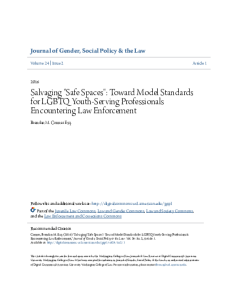
Brendan M. Conner; Journal of Gender, Social Policy, & the Law
Keywords: Best Practices; Child Welfare; Juvenile Justice; Law Enforcement; Resources for Providers
The concept of “safe space” for lesbian, gay, bisexual, transgender, and queer (“LGBTQ”) young people is commonly associated with the responsibility of primary and secondary school educators to create safe havens for LGBTQ students from their age peers, by establishing educator-enforced space for dialogue and accountability around name-calling, bullying, and other forms of abuse. The term is also applied in child welfare and juvenile justice reform efforts, particularly in the development of safer placement and housing classification protocols, as well as and in sensitizing youth-serving professionals to the needs of LGBTQ young people. Yet “safe spaces” reform efforts have failed to advance best practice guidelines for youth-serving professionals to ensure safety for LGBTQ youth from one of the primary perpetrators of violence and harassment against them: law enforcement. [Summary from resource.]
File : pdf with 0.40 MB in size
Conner, Brendan M. Esq. (2016) “Salvaging “Safe Spaces”: Toward Model Standards for LGBTQ Youth-Serving Professionals Encountering Law Enforcement,” Journal of Gender, Social Policy & the Law: Vol. 24: Iss. 2, Article 1.